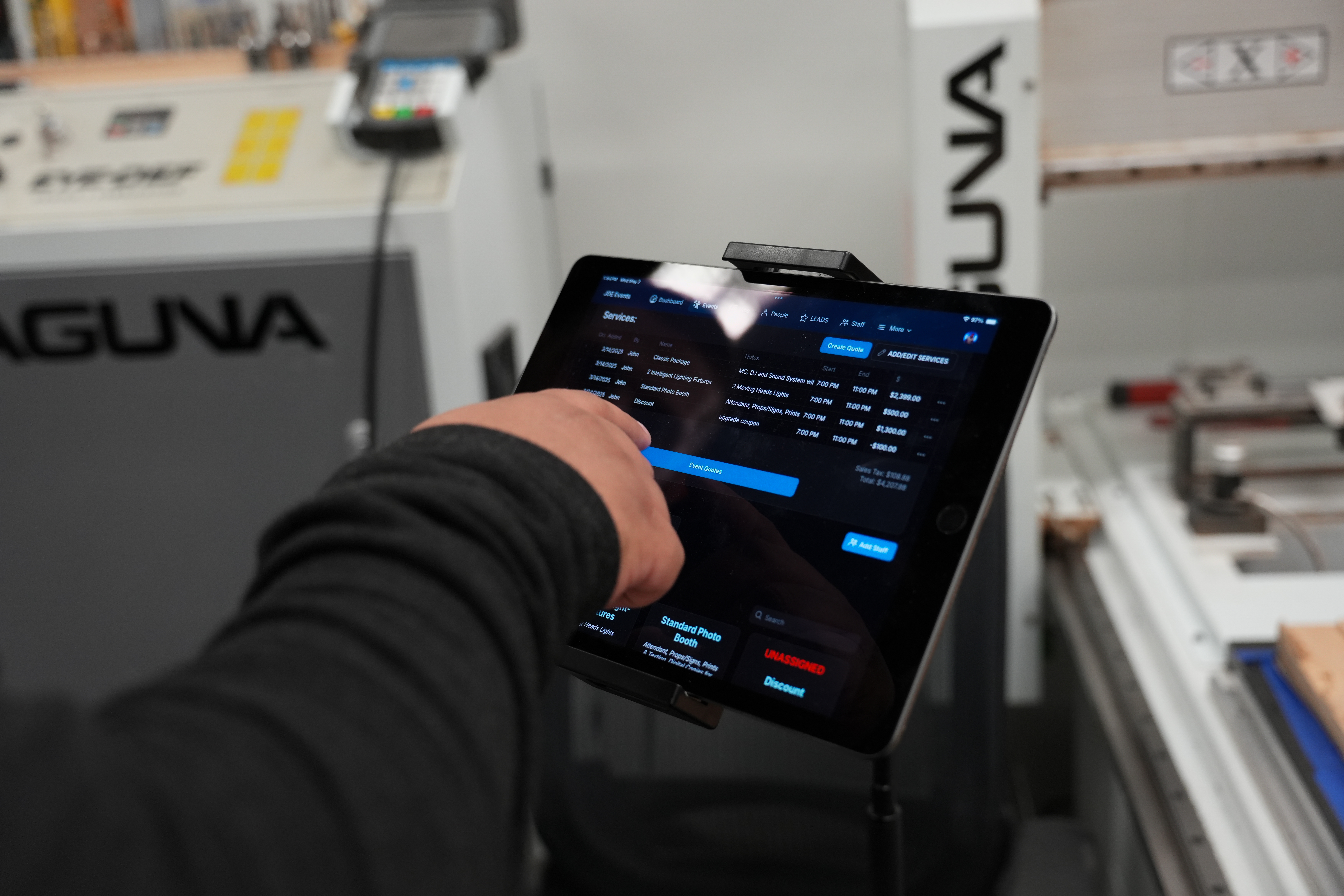The digital transformation noise is overwhelming. AI agents promising to run your entire business. Experts claiming you need to automate everything yesterday. Software vendors flooding your inbox with "revolutionary" solutions.
You're not alone if you feel paralyzed by the options.
Many business owners we speak with want to "finally automate something" or "do something with AI." But here's the problem: You can't automate what you don't perfectly understand. AI won't help you if your operation process isn't 100% clear.
This guide gives you a clear path forward to digital transformation for your business operations.
The real problem with digitalization
For most medium-sized businesses, digital transformation can feel expensive, endless, and prone to failure. You're not wrong. Research shows that 70% of digital transformation projects fail to meet their objectives.
A common mistake? Thinking digitalization means spending hours comparing SaaS tools.
Digitalization doesn't start with tool searching. It starts somewhere else entirely.
It starts with understanding what you actually do.
Most business owners skip this crucial foundation and jump straight to solutions. They research project management tools before mapping their current project workflow. They compare CRM systems without documenting their sales process. They evaluate AI tools before clarifying where AI could actually take over and where a human decision is still needed.
This backwards approach explains why so many digitalization efforts fail or deliver disappointing results.
The alternative is simple: start with what you have, then build solutions that match your reality.
Here's exactly how to do it.

Your 7-step path to successful digitalization
Step 1: Make every step visible
Pick one process that consistently frustrates you, like sales follow-ups, employee onboarding, or expense approvals. Open a document and write down every single step:
- Who does what?
- What decisions need to be made?
- Where does it regularly get stuck?
- Where do people search for information or have follow-up questions?
- Where is copy-pasting data or duplicate entries needed?
Don't solve anything yet. Don't search for software. Just make visible what currently exists. Write down every step from the first action to closing this task.
Step 2: Quantify the chaos
Now assess your current state with real numbers, but don't just measure—start questioning what deserves to be measured at all.
First, get the hard data:
- How often does this process happen?
- How many hours per week does it consume?
- Who's involved and for how long?
Track these specific metrics:
- Time spent on recurring steps
- Number of handoffs between people
- How often things get stuck or delayed
- Errors that require rework
Calculate the real cost: If two team members each spend 8 hours weekly on this process, that's 832 hours annually. At $45/hour, you're losing $37,440 per year on just one inefficiency.
As you track each step, ask the hard questions:
- Is this step truly essential?
- What adds no real value?
- What can we stop doing entirely?
- What's the worst thing that happens if we skip this?
Real elimination in action: While tracking a client onboarding process, one business discovered they were sending three separate "welcome" emails because different departments had created their own versions over time. The customer only needed one. Two steps eliminated, zero impact on quality.
Note: Advanced cost analysis of hidden expenses:
- Opportunity cost of delayed decisions
- Customer frustration from slow processes
- Employee burnout from repetitive tasks
- Errors that damage reputation
Data structure tip: Behind every process lies data. Customers, orders, projects, team members, documents. While you're analyzing and eliminating steps, move this information from Excel spreadsheets and email threads into structured data using a relational database like Glide.
Step 3: Define your ideal vision
If you could redesign this process from scratch, how would it work perfectly? When would it feel like "magic"? Think without limits first.
Ask these specific questions:
- What would the experience be like for each person involved? Consider your employees, customers, suppliers, and yourself. How would their day improve?
- How would customers notice the improvement? Faster responses? More personalized service? Fewer errors? Better communication?
- What information would appear automatically when someone needs it? Instead of hunting through emails or asking colleagues, what data should be instantly visible? Think customer history, project status, inventory levels, or team availability.
- Where would decisions happen faster? Which approval bottlenecks could be eliminated or streamlined?
- What would eliminate the most frustration? What causes your team to say "I hate doing this" or "This always takes forever"?
- How would you know something was working well? What metrics or signals would show success?
Example transformation: Instead of "Sales follow-up takes too long," envision: "When a prospect shows interest, they automatically receive personalized information, the sales rep gets notified with full context, and follow-up tasks are created based on prospect behavior."
Tip: avoid focusing only on your own experience, not your team's or customers'
To get inspiration: Spend 20 minutes in Glide exploring workflow possibilities for your documented process.ou. Test features with your data, like AI functions, automations, calculations.
Step 4: Simplify before you digitize
Once you know what must stay, make it as straightforward as possible.
Specific simplification techniques:
- Combine similar steps: If you collect customer info in three places, design one related place.
- Eliminate approvals that don't add value
- Reduce handoff
- Standardize decision criteria: Instead of "use your judgment," create clear if/then rules
Example: A client approval process had 7 steps and took 2 weeks. After simplification: 3 steps, 3 days, same quality control.
The difference between digitizing and optimizing: Digitizing puts your current process online. Optimizing improves the process first, then puts the better version online. Always optimize first.

Learn all about intelligent automation
Read the guide

Learn all about intelligent automation
Read the guideStep 5: Add intelligent automation
Once your process runs smoothly, introduce AI thoughtfully. Use intelligent automations that can analyze data and trigger actions, but keep humans in the loop for important decisions.
How to choose your first automation:
- Pick something that is recurring and has clear rules
- Choose tasks where errors are costly or embarrassing
- Start with automations that can already use AI
Implementing "human in the loop" effectively:
- AI handles routine decisions, humans handle exceptions
- AI provides recommendations with confidence scores
- Set up approval workflows for high-stakes decisions
Example: An AI agent processes support tickets, categorizes them, and routes simple ones automatically while flagging complex issues for human review.
ROI calculation example: Automating a 10-minute task that happens 5 times weekly saves 260 hours annually. At $45/hour, that's $11,700 in savings for probably 2 hours of setup time.
Common beginner mistakes:
- Trying to automate the most complex process first
- Automating before simplifying the process
- Not testing with a small volume first

Step 6: Create AI agents
AI agents are digital specialists—each designed to excel at one specific, repetitive job. They take input, process it using AI trained for that exact task, and deliver results ready for human review.
Smart AI Agents for SMEs:
- Resume screening and candidate ranking
- Customer inquiry analysis and response drafting
- Sales research and prospect summaries
- Document review and data extraction
Real impact: Build-360 cut customer update time by 90%. Their AI agent processes project info and site photos, creating comprehensive updates in 2-3 minutes instead of 30+ minutes manually.
How to choose: Pick your team's biggest time-waster that involves reading, evaluating, or analyzing. Look for tasks that happen multiple times daily where speed and consistency matter.
What to avoid
Don't spend 5 hours searching for tools before understanding what you need. Think first, shop later.
Don't overcomplicate. Simple processes are easier to digitize, automate, and improve.
Don't jump into automation before clarifying your process. You'll automate chaos instead of efficiency.
Don't build until you understand what's truly necessary. Requirements change when you really understand the problem.
What you can do today
- Write down 3 operational headaches you're experiencing right now
- Choose the simplest one to tackle first
- Open a free Glide account to create relational databases and test workflows
Need help getting started? Check out Glide University for tutorials or connect with a trusted Glide expert who can guide you through the process.
The bottom line
Digitalization isn't about finding the perfect tool or implementing the latest AI trend. It's about understanding your processes deeply enough to improve them systematically.
That's your path forward.
When you're ready, try starting with a spreadsheet or process you do frequently and turning it into a simple Glide interface. If you're needing for a more in-depth transformation, reach out to a Glide Expert or agency like Kwapso. We can bring our years of experience and technical expertise to the table, advising you and helping you digitize your processes in the most effective (and fastest) way possible.






